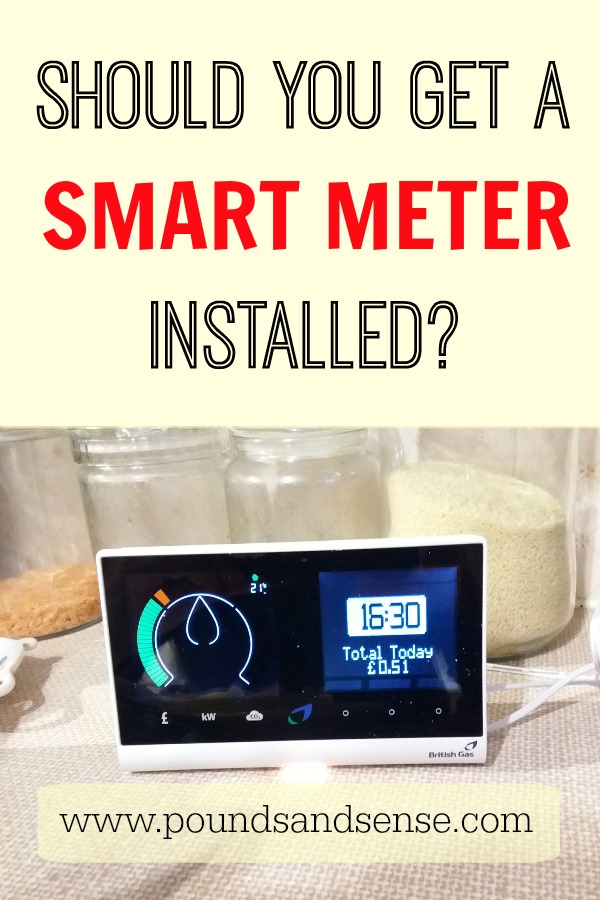Should You Get a Smart Meter Installed?
If you haven’t yet been offered a smart meter, it’s highly likely that in the coming months you will.
The government requires energy suppliers to offer smart meters to all homes and small businesses across Great Britain by 2020. Smart meters are coming to Northern Ireland as well, though a definite timescale hasn’t been decided yet.
There is a lot of confusion about smart meters, so today I thought I’d try to shed a bit of light on the subject. I have had a smart meter myself for nine months, so will be offering some thoughts based on my own experience too.
What Are Smart Meters?
Smart meters are a new generation of gas and electricity meters that replace the traditional meters (including prepayment meters) most of us have under the stairs or in the hallway.
Smart meters are so called because they send readings automatically to your energy supplier via a dedicated wifi network. That means you will no longer need visits from a meter reader or have to submit readings yourself.
The other aspect of smart meters is that they come with an electronic in-home display (see picture above). This reveals how much energy you’re using in near real time (they update at least every 10 seconds for electricity and every half-hour for gas). The display shows what your energy is costing you in pounds and pence (or if you prefer, kwh or CO2 emissions). It can also show how much you’ve used over the last day, week, and month.
Are You Obliged to Have One?
The short answer to this question is no. There is no obligation to accept a smart meter and you can decline the offer if you wish.
There is one caveat, however. If your existing meters have to be replaced for safety reasons or because they break down, smart meters may well be fitted in their place, as traditional “dumb” meters will no longer be made and become obsolete.
All meters have to be replaced when they reach the end of their working lives, so sooner or later you will almost certainly end up with one. Note, however, that you aren’t obliged to view the in-home display and can unplug it if you want.
What Are the Pros and Cons?
Here are some advantages of having smart meters installed:
- No more estimated bills.
- No need to arrange for meter readers to gain access (or submit readings yourself).
- Potentially there may be cheaper, smart-meter-only tariffs you can switch to (although this hasn’t happened very much yet).
- With the aid of the in-home display you can check how much energy you are using at any time, helping you to see where you can make savings.
- Getting smart meters installed is free (although of course we all pay ultimately through our energy bills).
Are there any drawbacks to having smart meters installed? Well, possibly. One is that currently if you decide to change energy suppliers, your smart meter may no longer work and you will have to revert to submitting meter readings yourself.
A new generation of smart meters (SMETS2) is coming that should work for any energy supplier – but for now, if you’re planning to switch suppliers, it may be a good idea to do this before getting a smart meter installed.
- If you have a SMETS1 meter of the type that most energy companies are currently installing, it may or may not work if you switch to a different supplier. If not, your new supplier may offer to install a new meter for you, or it is possible that your old SMETS1 meter could be upgraded to the SMETS2 standard. It’s complicated stuff, so I recommend this article (and reader comments) for an overview of the SMETS1 versus SMETS2 debate, and this one for a more technical account.
Another possible objection to smart meters is that they could encourage a miserly attitude to energy use and cause friction within couples and families. A female friend has refused point blank to have smart meters installed because (rightly or wrongly) she fears her husband would become an “energy fascist”, constantly turning down the heating and switching off the lights to save money. That is obviously an issue every couple needs to negotiate for themselves!
Getting a Smart Meter Installed
If you decide you want a smart meter, you can either wait to be contacted by your energy supplier or contact them yourself.
All the main suppliers have information on their websites about their rollout plans. There will also be a number you can phone to register your interest.
You will need to book a date and time for a fitter to install your meters. This is likely to take a couple of hours, and your gas and electricity will need to be switched off some of this time. The fitter will explain how the meters work and demonstrate how to use the in-home display unit. He/she will also offer some general advice on how to save money on your energy bills.
My Own Thoughts
As mentioned earlier, I had smart meters installed six months ago. It was pretty painless, and I have found it interesting to see how my energy consumption goes up and down. Here are a few thoughts based on my own experiences…
- Initially I found it disconcerting how the display jumped into the amber or red warning zone when using my electric kettle or toaster. However, I quickly realised that as you only use these devices for a few minutes at a time, they don’t add massively to your energy costs.
- A particular benefit has been that if I glance at the meter and see that my current consumption is higher than normal, it nudges me to investigate why. A couple of times the cause turned out to be an electric heater I’d forgotten to switch off. From a safety angle as well as a monetary one, I was glad to be alerted to this!
- The display unit has a budgeting feature, where you can set a daily target for your energy consumption. It then shows whether you are on target to achieve this or not. Initially I liked this, but as winter set in last year I realised that targets set in the summer are no longer realistic as the days get shorter and colder. I guess I could reset my budgets every month, but personally I just ignore this feature now.
All things considered, though, I do feel that having a smart meter has been beneficial to me and I am definitely saving on my energy bills (and feel reassured that they are more accurate).
Obviously it’s a decision everyone needs to make for themselves, but I think most people will benefit from having smart meters installed. And if they help reduce overall energy consumption, that has to be good for the planet as well.
That’s my view anyway, but what do you think? Please leave any comments (or questions) below.












